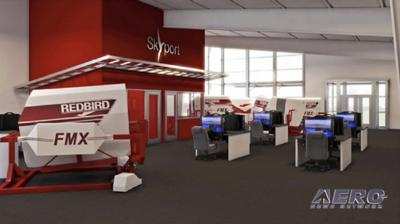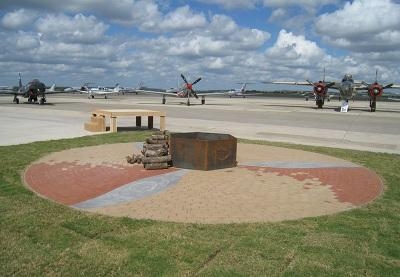Wed, Oct 24, 2012
Redbird’s Skyport Laboratory Creating Pilots In Two-Thirds The Time For Much Lower Cost
After one year of turning students into Private Pilots for a flat fee of $9500, Redbird Flight Simulation’s Skyport reports their experiment in simulator-based training is working. At its Migration Flight Training Conference this week, Redbird announced the school has graduated 20 Private Pilots, as well as completed 18 instrument ratings, one multi-engine rating and one instrument instructor certificate. It took an average of 38 flight hours to complete the private pilot rating, which is less than two-thirds the national average.

“We found that we needed to completely rethink the learner, the materials and delivery methods,” says Roger Sharp, Director of Flight Operations for the Skyport. Sharp says the Skyport and Redbird have 46 products that have come out of this process so far, with more on the way. “We identify better methods every week,” Sharp says of the simulator.
Some of these products are high-tech, such as a Guided Independent Flight Training or GIFT, which demonstrates maneuvers in the simulator and scores student performance on that maneuver automatically. Sharp points out that most instructors don’t enjoy teaching the basics in a simulator, so GIFT and the communications-training software Parrot automate the process until the student is ready to practice with live person watching. The instructor can be more a coach and mentor that a primary teacher, which suits most instructors better.
The Skyport has several low-tech solutions as well. Instead of the cinderblock-sized FAR/AIM study guide, Skyport students get slim study guides of key points. The 56 study items on VFR regulations fit into a 28-page book. “Not only can we reduce the amount of information the learner has to absorb, but we greatly increase their depth of understanding of important subjects at the same time,” says Sharp. Like the simulation tools and training aids, these products will be available to the public in the near future.
Given the pass rates and time to complete their certificates, the system seems to be working, but Skyport feels there’s plenty of room to do better. “We have months of work to refine our current methods,” says Sharp, “but there is much more we can study in this laboratory. It’s up to the industry to propose what that will be.”

Meanwhile, a roaring fire marked the opening evening for Redbird Skyport’s second annual Migration Flight Training Conference. The fire was in a “fire hub,” a creation of the Recreational Aircraft Foundation (RAF). The hubs are 22-foot-diameter circles lined with bricks and segmented by three 9-foot aluminum propeller blades radiating out from a central hub containing the fire.
RAF fire hubs are both practical and symbolic. “Since we do a lot of flying and camping, we think of a fire as the main gathering place for camaraderie and bonding,” says Tricia McKenna of the RAF. On the practical side, the fire hubs are fundraisers for the RAF to promote its efforts to promote recreational and backcountry aviation. Donors buy engraved bricks for $100 each from the RAF website and have them sent to the fire hub of their choice for installation. The hubs are financed by a local sponsor for $12,500 and are constructed and installed by RAF volunteers.
The inaugural fire hub was unveiled at Lakeland, FL, earlier this year. This is the second fire hub in a plan the RAF hopes will create at least 50 such fire hubs, one in every state. McKenna says that in addition to the Lakeland and San Marcos hubs, five others are in the works.
More News
Airbus Racer Demonstrator Makes Inaugural Flight Airbus Helicopters' ambitious Racer demonstrator has achieved its inaugural flight as part of the Clean Sky 2 initiative, a corners>[...]
A little Bit Quieter, Said Testers, But in the End it's Still a DA40 Diamond Aircraft recently completed a little pilot project with Lufthansa Aviation Training, putting a pair of >[...]
Line Up And Wait (LUAW) Used by ATC to inform a pilot to taxi onto the departure runway to line up and wait. It is not authorization for takeoff. It is used when takeoff clearance >[...]
Contributing To The Accident Was The Pilot’s Use Of Methamphetamine... Analysis: The pilot departed on a local flight to perform low-altitude maneuvers in a nearby desert val>[...]
From 2015 (YouTube Version): Overcoming Obstacles To Achieve Their Dreams… At EAA AirVenture 2015, FedEx arrived with one of their Airbus freight-hauling aircraft and placed>[...]
 Airbus Racer Helicopter Demonstrator First Flight Part of Clean Sky 2 Initiative
Airbus Racer Helicopter Demonstrator First Flight Part of Clean Sky 2 Initiative Diamond's Electric DA40 Finds Fans at Dübendorf
Diamond's Electric DA40 Finds Fans at Dübendorf ANN's Daily Aero-Term (04.23.24): Line Up And Wait (LUAW)
ANN's Daily Aero-Term (04.23.24): Line Up And Wait (LUAW) NTSB Final Report: Extra Flugzeugbau GMBH EA300/L
NTSB Final Report: Extra Flugzeugbau GMBH EA300/L Classic Aero-TV: 'Never Give Up' - Advice From Two of FedEx's Female Captains
Classic Aero-TV: 'Never Give Up' - Advice From Two of FedEx's Female Captains




